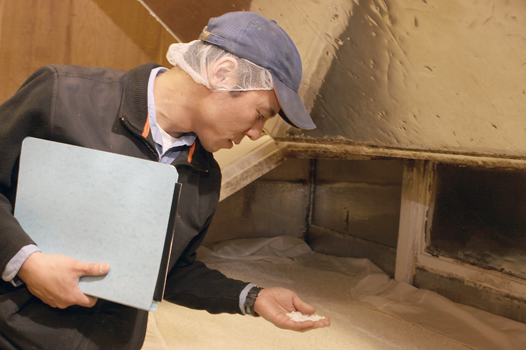Hollister is a center for high-quality sake brewing
It may be hard to believe, but some of the world’s finest sake
is produced in Hollister and has been made here for the past 28
years.
Ozeki Sake, located at 249 Hillcrest Road in Hollister, started
as an experiment; a joint venture between Ozeki sake of Japan and
San Benito Vineyard. Since the vintners already had a winery at the
location they thought it would be interesting to produce sake as
well.
Hollister is a center for high-quality sake brewing
It may be hard to believe, but some of the world’s finest sake is produced in Hollister and has been made here for the past 28 years.
Ozeki Sake, located at 249 Hillcrest Road in Hollister, started as an experiment; a joint venture between Ozeki sake of Japan and San Benito Vineyard. Since the vintners already had a winery at the location they thought it would be interesting to produce sake as well.
San Benito Winery went bankrupt several years later and at that time Ozeki bought the shares of the company and moved into the entire location.
Sake is a type of wine produced from rice instead of grapes. The rice for the sake is grown in Sacramento and shipped to Hollister.
“Hollister was the ideal location for Ozeki, because it is located between Los Angeles and San Francisco – the two biggest sake consuming areas in California,” said Kozo Yamamoto, Ozeki Sake (U.S.A.) general manager.
Ozeki’s history in Japan dates back to 1711 when the company’s predecessor Osakaya Chobei first introduced his sake on the market.
Sake is produced through the fermentation of rice. The process starts with the handpicking of selected brown rice.
Ozeki distinguishes itself from its competition by using short grain rice, Yamamoto said. He explained that most of the competition uses medium grain rice for producing sake, but the best grain for sake is short grain. Medium grain rice is cheaper than short grain rice, so most sake companies use the latter, but it is the quality of the short grain that is the reason that Ozeki uses it to produce superior quality sake.
The quality of the water used in brewing sake is also important. In Japan, brewers take advantage of the various kinds of natural water to make excellent sake. Part of the reason Ozeki located in Hollister was because of the water. Many tests were made at different locations before they discovered that Hollister offered the purest well water, which contained the exact elements needed to make their sake.
To make sake, brown rice is put through a milling process where the outside of the rice is shaved off leaving only the white inside. How much of the rice is shaved off affects the quality of the sake. For regular sake the rice is polished 30 percent, while the premium sake is polished to 50 percent. Through polishing the rice, Ozeki is able to get rid of unwanted extras such as proteins and fats that would otherwise take away from the quality of their wine.
The rice is then washed, soaked and steamed before koji is added. The room where Ozeki adds Koji is sacred and as such employees take off their shoes before entering the room as a show of respect. Koji is a type of mold that produces enzymes that convert starch to sugar. Since rice does not naturally contain sugar, koji has to be added in order for fermentation to occur.
The sake factory has a sweet smell that lingers in the nose and makes one think of flowers.
In typical wine fermentation yeast is added to the grapes, which naturally contain sugar, in order to produce wine. With sake, koji is added to the rice to produce the sugar, which is then mixed with the yeast to produce the sake.
Sake typically takes three weeks to ferment. At that point the sake mash is pressed into fresh sake. The fresh sake tastes sweet and somewhat bubbly, since one of the by-products of fermentation is carbon dioxide.
The fresh sake is filtered twice, pasteurized and stored for an average of six months. The aging depends on the quality of the sake, but the typical aging is three to six months.
After the sake has been stored for the proper amount of time it is blended one final time, run through a final filtration and bottled.
There are several different types of sake and each sake has its own texture and taste. Ginjoshu is characterized by a fruity somewhat floral bouquet and a clear crisp flavor. Nigorizake looks milkier in color since it is only lightly filtered using a coarse textured cloth. Sake can be enjoyed at a wide range of temperatures. Traditionally it is served hot, but it can be iced or even served at room temperature, depending on how one wants to enjoy the beverage.
Of the 25 employees that Ozeki employs at their Hollister Plant, eight of them come from Japan; the majority are locals from Hollister. Yamamoto has been at the Hollister plant for two years. Before he worked for Ozeki in Japan. He enjoys life in Hollister though and finds the pace of life to his liking.
One of the things that Yamamoto has noticed is how much Hollister is developing and as such, how much more interest there is in sake today than a few years ago. In fact, Ozeki ships 400,000 cases of sake around the globe each year, equivalent to 600,000 gallons annually.
There are two Japanese restaurants in Hollister currently and both stock Ozeki sake regularly. Many grocery stores have also started to carry the sake, but locally it is only available at Hollister Supermarket.
Patrick O’Donnell can be reached at po*******@**********ws.com.










